Severed Limbs and Soiled Capes: The Place of the Super-Macabre in Comics
As anyone who knows me learns sooner or later, my first ever fresh-off-the-stands new comic was 2000’s The Amazing Spider-Man (Vol. 2) #17 by Howard Mackie, John Byrne, Dan Green, Joe Rosas, Richard Starkings, and Troy Peteri when I was 4 or 5 years old. Aside from getting me to think Venom was the coolest supervillain ever (not entirely borne out) and that Mysterio also ruled (ENTIRELY borne out), the issue was mostly notable for Peter Parker getting arrested because unlikely circumstances caused a pair of cops to think he was a cokehead yuppie, and then losing out on a job interview. The centerpiece though was the lingering death by slushification of the Sandman, and a bit involving what I as a small child thought was a bottle of ketchup that lingered in my mind for decades:
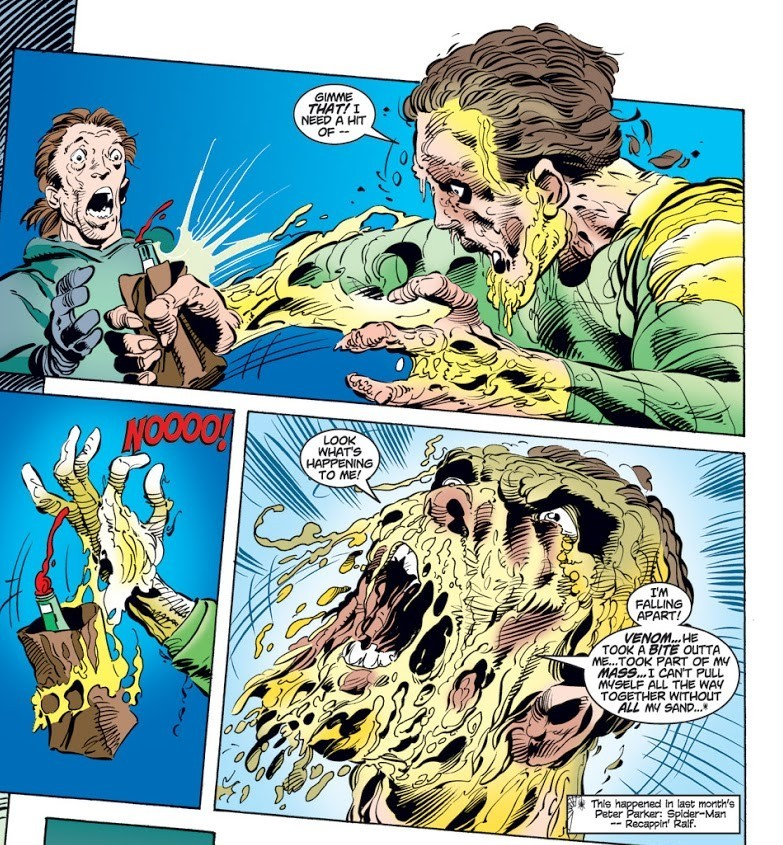
Looking back, the actual panel of the booze falling through him isn’t that severe, but in my young mind it was a gut-churning visual metaphor for blood as Flint Marko’s body grotesquely failed him. It didn’t have an immediate impact on me; I didn’t get into slasher films and in fact tend to be a big weenie regarding cinematic horror, I didn’t dig up EC backlogs, and this was soon followed by the far more age-appropriate Superman & Bugs Bunny and the Essential Spider-Man TPBs. Still, it established a trend: my third grade teacher Mrs. Reed got an Amazing trade for the class’s book-nook for me without paging through and realizing this was JMS and Romita Jr.’s initial Morlun arc where Spider-Man’s hunted down and beaten to a semi-sensate lump of gristle and pulp, and I ate it up.
Years later my introduction to weekly comics was Batman R.I.P., a comic featuring an amnesiac heroin-addicted Batman wandering the streets of Gotham in a stupor (despite its triumphant climax), a Joker with carved cheeks and a split tongue, and a threatened lobotomy upon the former Robin the Boy Wonder, rooted in the drug and sex-fueled fetishistic casual cruelities of the untouchable monstrously wealthy. It all took Gotham to a tonal limit I hadn’t previously imagined and made the climax all the more triumphant. Not long after came Irredeemable, a comic that would make me interrogate my love of the Superman archetype in ways that would eventually lead to my future in comics criticism, with its tales of a hero’s desperate need for validation giving way to finding bliss in the unthinkable horrors he can rain down upon the defenseless populace that once loved him.
As it happened, I was arriving at the crest of a 2000s wave that was about to crash in the public eye. Critical discontent had been building since the one-two brutal bunch of Identity and Infinite Crisis bringing a new scale of violence to DC Comics’s mainstream titles, while at Marvel and increasingly in the creator-owned scene, Mark Millar defined his personal brand of gross-out super-grindhouse blockbuster pitches. By the time of Blackest Night’s army of sadist Silver Age zombies, Siege featuring one superhero tear another in half in an entrail-strewn double page splash, Ultimatum’s notorious generational failure, and Superfriends’ Wonder Dog eating Marvin and critically injuring Wendy, any public appetite for this type of material was quashed in the face of it having immediate and long-ranging effects on the ongoing shared universe narratives.
DC’s New 52 relaunch scaled back to a relatively tame 1990s level of carnage that was still met with no small backlash, while Marvel entered the Heroic Age followed by Marvel NOW!, and further forays into the territory such as Injustice and – relative to the average caped blockbuster fare – Zack Snyder’s DC films were broadly rejected on sight. For myself, I largely accepted the received narrative that despite a few good examples here and there, this was all a dreadful defilement of our allegorical champions, even if I maintained an undying affection for comics where Spider-Man gets the absolute hell kicked out of him.
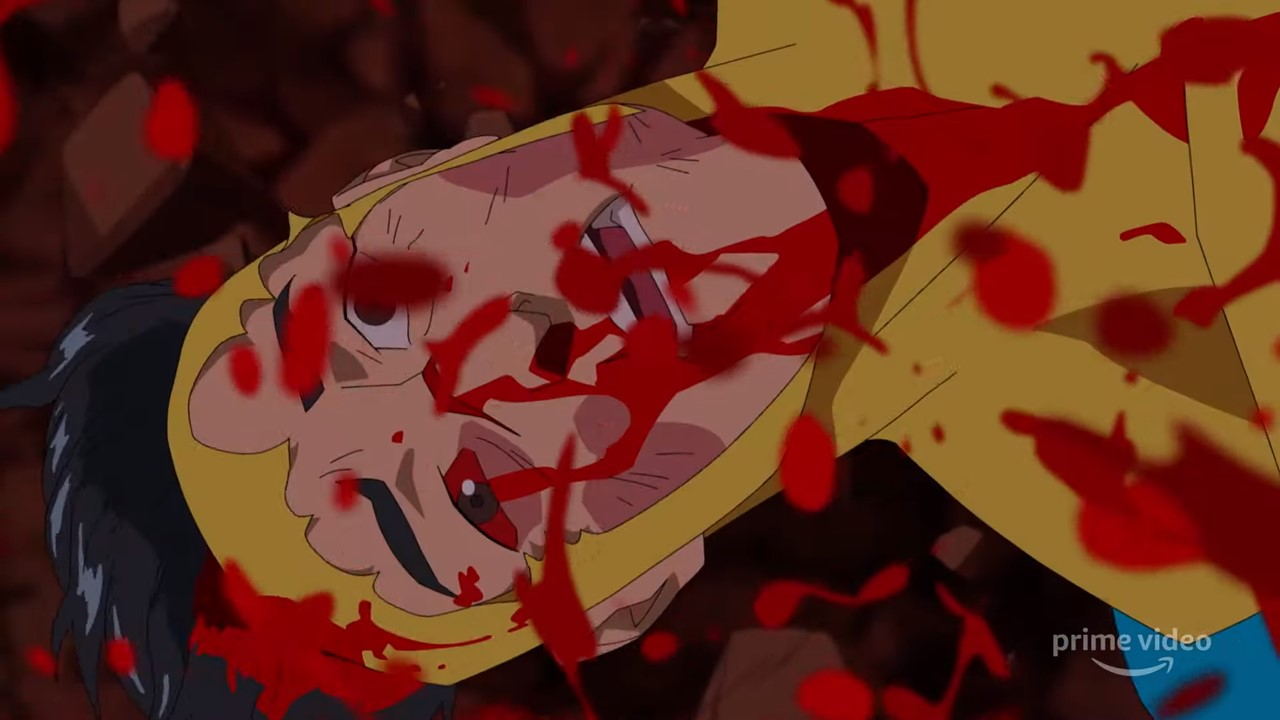
Given a few years though? For all our protests, it looks like we’ve got the cultural taste for radioactive blood back in our mouths. The Immortal Hulk’s eschatalogical body horror came roaring out of the gate heralding a new era of comic thrills and chills. DCeased brewed up its own apocalyptic mini-imprint alongside its spiritual companion DC vs. Vampires. Standalone titles titles like Batman: Last Knight on Earth and Suicide Squad: Blaze hinge on the awful ends of Superman and the Justice League, through humanity decisively rejecting their values or sheer inadequacy in the face of an unprecedented threat. Two of the most critically acclaimed superhero TV series currently on the scene are the outrageously gory The Boys and Invincible.
Most would agree there’s a higher average quality to those than the likes of Ultimatum’s limp pandering towards shock value. There’s also the major difference that this latest round of adventures generally has no impact on the ongoing storytelling of the major beloved DC and Marvel characters – even Hulk can regenerate from anything Al Ewing puts him through – letting the ugliness live in its natural habitat at the fringes of the superhero fantasy rather than thrusting the metaphorical and literal intestines into the spotlight where there’s no avoiding it for the squeamish and disdainful. But the fact is, divested from impact on the ongoing adventures, there’s a thirst in us for this flavor of Super-Macabre. To watch our saviors mangled, degraded, out of control. Dragged from the sky onto our level and stomped into the mud.
Is there some unique contemporary cultural factor behind the rise of such a trend? Some kind of spiritual rot claiming us, warping our perspectives to crave such horrors visited on our childhood heroes?
No. This is what we’ve always wanted.
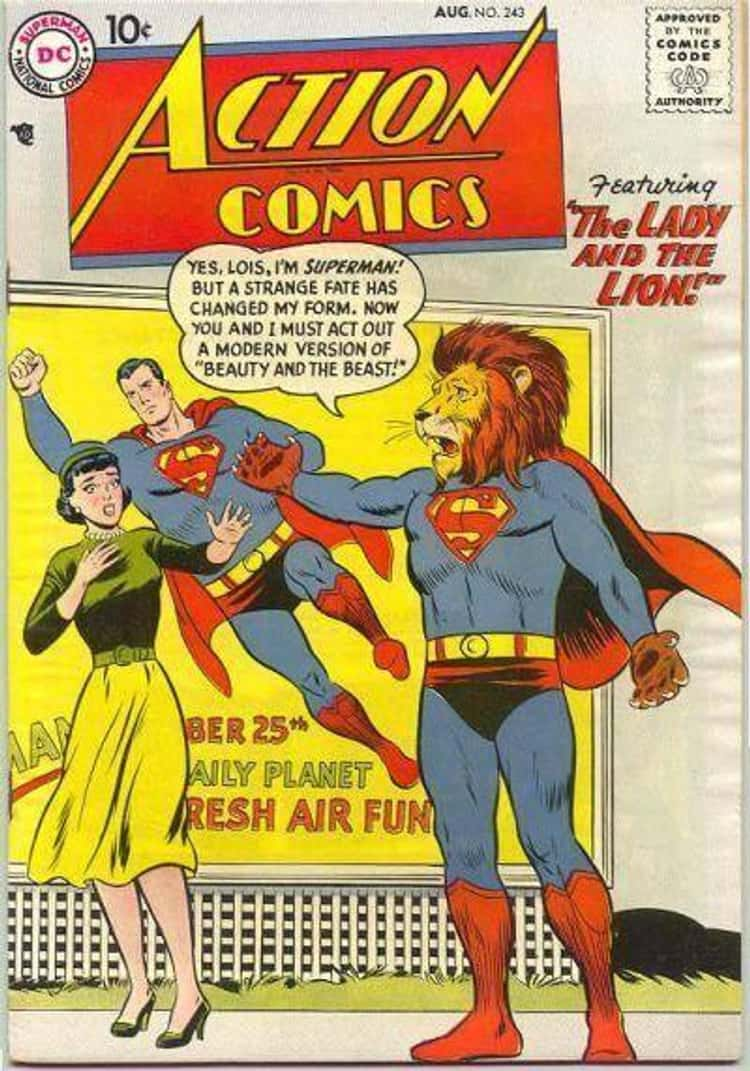
Once upon a time we kept it confined to the tasteful bounds of indignity rather than agony, but it was the hero comic at its most fanciful that embraced the notion of a superheroic body and ego ripe for torment. Hundreds of issues, thousands of pages, devoted to the nerve-wracking threat of secret identities exposed by scheme or maddening chance. Humiliating and potentially ruinous physical transformations by way of strange chemical concoctions or alien radiations with changes in shape, size, or species. Mind control and devious doubles that could destroy an already precarious social standing built over a lifetime. Ostracization and mockery from friends and family pending a twist reveal that it was all an elaborate setup to hoodwink a criminal or teach some vital social lesson via group shaming. Standalone ‘Imaginary Stories’ with license for everything to go completely to hell as anyone could die, permanently lose their powers, or otherwise see their lives bent devastatingly off-course.
The rending of indestructible flesh for our amusement is as storied and reliable a pastime of the cape comic as oaths of power and alternate universes; just one tailored to its time and conventions. There’s a reason the aforementioned Irredeemable per creator Mark Waid drew on this silver era when crafting its fallen crusader, with its idea of a Superman most scared of no longer being loved. That it would give way to the Plutonian’s nightmare of it all coming true alongside an entire pantheon of 21st century hero-horrors is just the domino mask coming off.
Maybe there’s something in seeing the basic rules broken; that sense of taboo in the idea of Elmer Fudd actually putting one between the rabbit’s eyes we like to think of ourselves as having long since outgrown, but that was more than enough to get us several seasons of Happy Tree Friends. One contingent would say the desire for this breed of four-color violence speaks to a deep insecurity in the face of moral rectitude and desire to absolve ourselves of the burden of a higher standard; others would contend that it’s when brought lowest that the will to rise is most profound. Or perhaps in a genre increasingly invested in portraying its figureheads as impossible exemplars of compassion and decency meant to inspire their readership, it was simply inevitable that the superhero, forever defined by conflict, would be met by an equal and opposite swell of raw sadism.
Go further back even than the 50s and at the early roots of the hero you find them as the very enactors of that sadism – the caped crusader gleefully mowing down the opposition on the killing fields of Batman #15’s cover while Robin feeds him ammo, Stardust the Super-Wizard dreaming utterly unimaginable punishments for his criminal victims, the logical descendants of their pulp antecedents’ most brutal extremes. And while the ‘mainline’ folks may have cleaned up their acts, those early acts reverberate forward into the Spectre’s outlandishly violent judgements, the lovingly rendered atrocities of the Punisher, the sporadic rises and falls of Wolverine and Deadpool and Black Adam, suffering forever for the right to be the kind of monsters those on center stage can never be allowed as. The cape comics’ grisly streak is always bubbling, foreground or background or unconscious, waiting for the chance to break loose.
But if the heroes can be subjects of cruelty as often as adoration? So too do they function as leads inviting masochism. Which leads me to the text that gripped me most of all at a young age, the truest expression in my mind to this day of that notion of Super-Macabre: Robert Kirkman, Sean Phillips, June Chung, and Rus Wooton’s Marvel Zombies: Dead Days.
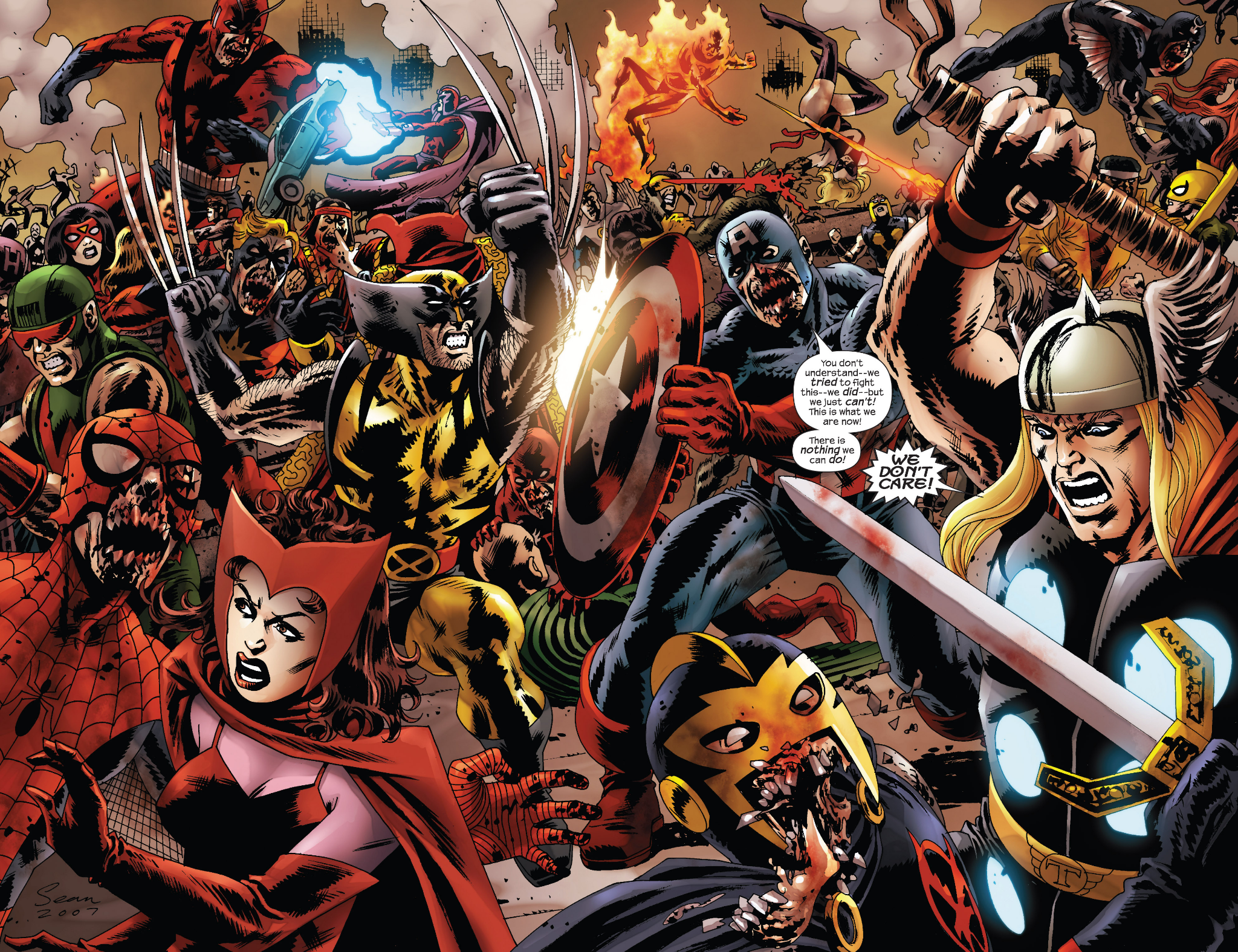
As a summer of ‘07 release when I was 12, this would’ve been almost exactly a year before I got into the weekly comics game; like ASM #17 this was a grocery store purchase by my mom on my behalf. It’s a purchase I remember well, because we were visiting my aunt and grandmother (at least I hope we bought it during the visit, since if I was seen bringing it cross-country that’d make the following events even more awkward) and the latter ended up paging through it with a befuddled “Oh. That’s awful.” My mother later informed me she wouldn’t have gotten it if she’d known it opened with Spider-Man cannibalizing Mary Jane. I was blindsided, mortified, and most importantly I knew this was the GOOD shit. This was a comic I WASN’T SUPPOSED TO HAVE, and we all KNEW it, but too late now, sucker.
I didn’t know the larger meta context that this issue resided in as almost a sort of gag-within-a-gag: that this was the deadly serious prequel to a pair of outlandish black comedy minis involving an army of Zombie Galactus Superheroes who respond to finishing off the last of all life in creation with “Damn…I can’t believe we ate the whole thing.” And I don’t know if it would have mattered. Even now I’m too close to say whether Kirkman killing panicked Marvel heroes for 40ish pages is ‘good’ or not. All that matters is the Marvel Zombies were, and still are, the most terrifying monsters in fiction to me.
Not for anything as banal as them being monsters who also have optic blasts and web shooters, but because they’re still them. They’ve not slavering beasts; those infected with The Hunger think and feel exactly as they always have. And the understanding of what they’re doing doesn’t make them hesitate for a second. In the face of this indescribable pain and craving, none of the morals and convictions and loves that have had them hold strong across decades of challenges and triumphs matter. Somewhere, in some corner of the mighty Marvel multiverse, there is something so awful and inevitable that everything your heroes have ever stood for means nothing in the face of it, the need so absolute that most can’t even bring themselves to feel guilt for what they’ve done in its name.
And beneath the revulsion, beneath any fist-pumping at seeing the silly kids heroes going totally sicko mode, beneath the existential panic…isn’t there a sort of awful comfort in that idea? That it might all go down in flames. That love isn’t enough, that no force of will can hold strong for all time, that we’re not going to figure it out. To fall forever and be freed from the grinding endless effort of hope.
In a 21st century where the superhero has become a pop-cultural default, it can be easier and easier to hate the face declaring the day saved. That can be a blandly handsome 70 foot IMAX face nobly sweating with the exertion of fighting to keep the nightmare world you live in from being changed; an identification figure it all turns out alright for in the end, in spite of your every nerve screaming this isn’t how anything works; a beatific role model mouthing platitudes at odds with all you know. Call it counter-programming, call it nihilistic catharsis, but for the right person at the right moment the right kind of exhausted? Maybe whether the hero was above or within us before being ground beneath the boot, that’s the truest appeal of all: in a world where the promises of the superhero seem impossible, maybe something in us is screaming to hear it might be the lie it feels like after all. To tear them apart along with it.
Thank goodness of course that the gross shit by the weirdos can never really stain the shine; that in the mainline movies and comics, the real world, heroes are still invulnerable, infallible, eternal. Thank goodness all that’s a hoax, or a dream, or an imaginary story.
Thank goodness someone’s coming to save us.
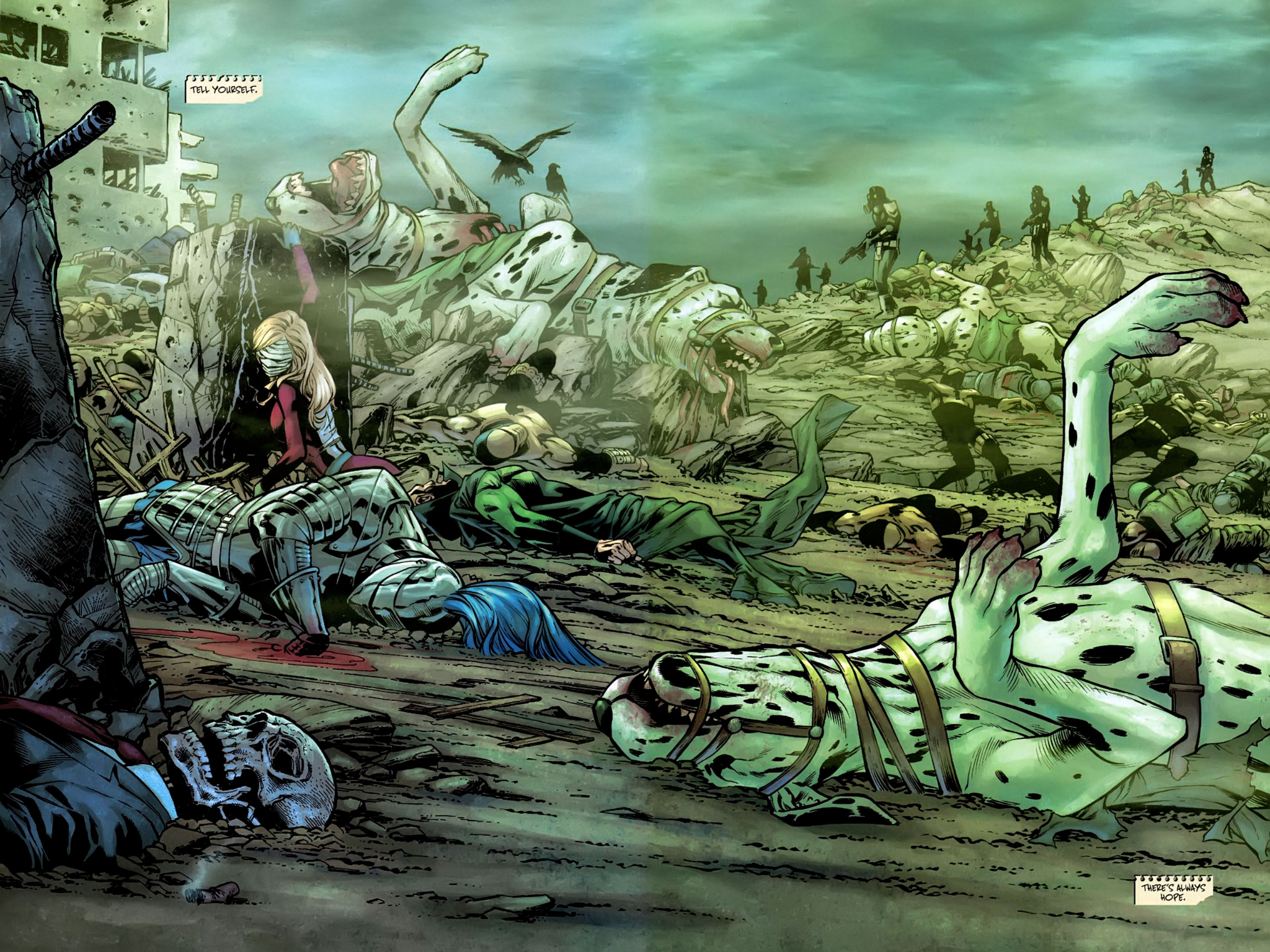
The post Severed Limbs and Soiled Capes: The Place of the Super-Macabre in Comics appeared first on Comic Book Herald.
